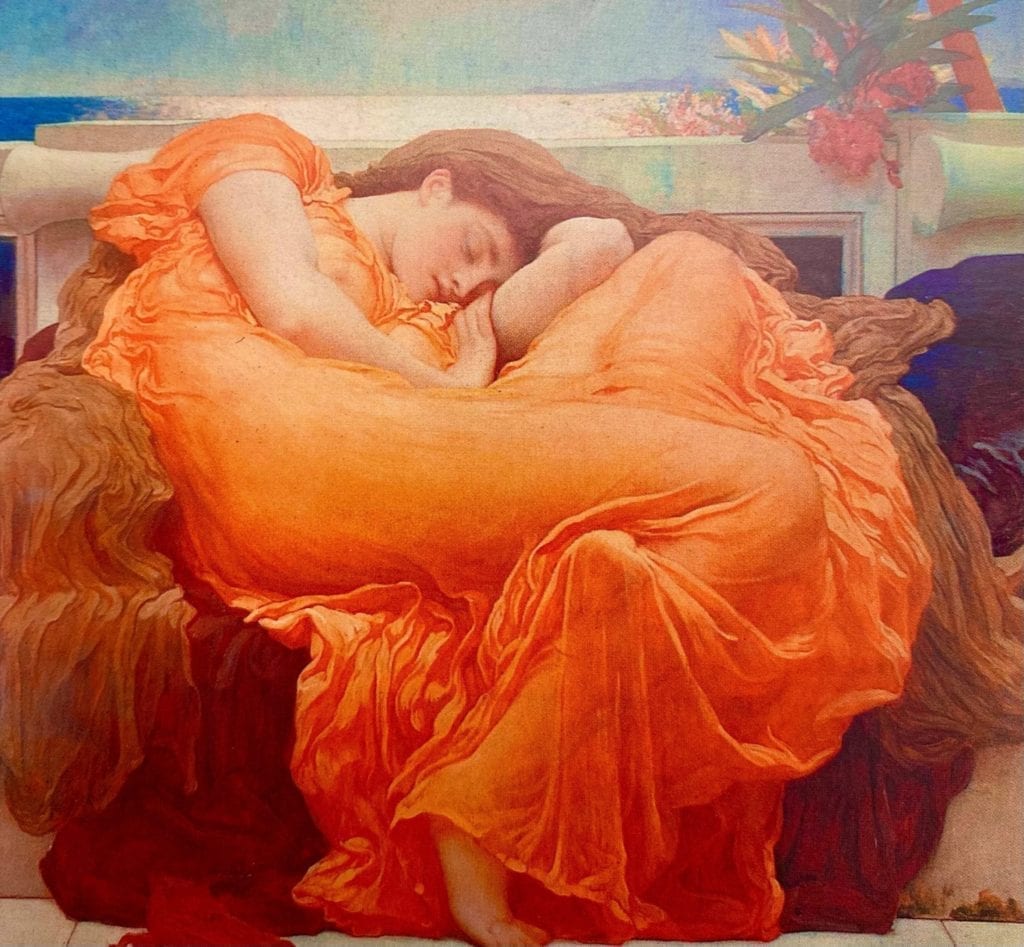Frederic Leighton fared as an underestimated salon painter up till 1895. Then he painted this masterpiece – Flaming June. It sings to us with radiant color and elemental symbols. Many see this painting as simple. It’s a beautiful woman in a glorious dress. They’re not wrong. But as with most masterpieces, more levels of meaning resonate here.
Click below for the podcast version of this piece.
The initial pulse check on this painting delivers heat. It’s titled Flaming June for good reason. Orange bursts through the canvas as cascading fire. The gown’s flames ripple like an out of control blaze. This lovely woman seems to sleep inside an inferno. Surrounding details balance this piece, though. It’s not only about fire. Leighton frames June with earth, sea, and air elements to harmonize the painting.
Not a mere portrait of a woman, Flaming June reveals a world unto itself. She sleeps and the painting encapsulates her like a dreamscape. But the wonders aren’t only in her mind. Orange envelopes her body in glorious waves. It’s a waterfall reflected in her infinite tendrils of hair. They reach almost as far as her clementine dress.
The chestnut brown of her hair represents the element of earth. It balances all the fire and water around June. The plant and flowers at our top right also resonate this earthy symbolism. Fire and earth suit this resplendent woman. She’s an iconic image of heat in the world of high art. Her vulnerable dreaming state evokes innocence. So, she’s more sensual than sexual – despite the sheer garment.
Water & Air Everywhere
The heart of Flaming June may be on fire. But it’s surrounded with cool breezes and silvery water. These elements bring a fresh balance to the piece. A shimmering sea behind June’s dozing figure shines like a bright light. Its iridescence feels like a dream. Brilliance glints by her head like fresh-caught fish scales glinting in sunshine. This coolness balances June’s heat. It slips into blue waves by the sides. That’s where reality peaks in from the reverie at this painting’s core.
Without these bits of blue Flaming June’s story takes place in dreamland only. But the seawater gives the scene a real setting. This undulating landscape breathes a sense of place into what’s otherwise a dreamscape. We know this because there are so few boundaries. The silvery sea slips into the white sky. June’s earthy brown tresses blend into her cascading orange gown. Sky and sea are one. June’s swimming in soft brown tendrils and caresses of orange silk.
If we place this work in art history, there’s even more to this theme of unifying differences. Frederic Leighton was an artist who fit into many different frames. A beloved and prosperous painter, Leighton also loved volunteering as a soldier. Painter James Whistler described him as:
Colonel of the Royal Academy and the President of the Artists Rifles – aye, and he paints a little!
Frederic Leighton painted Flaming June only about a year before his death. With that in mind, the painting crosses the boundary between an artist’s work and their legacy. Leighton was popular in his day. As a British painter, he made lots of money and was even knighted. But few would have guessed he’d paint a true masterpiece. His work fit into the category of salon paintings. Today’s equal might be an artist who does pieces to match interiors for one percenters. He far outdid himself with Flaming June, though. This beauty speaks to us beyond any decorator’s vision. It touches us today as a glorious masterpiece.
Flaming June – FAQs
Where can I see Frederic Lord Leighton’s Flaming June in person?
Flaming June heats up the collection at the Museo de Arte de Ponce in Puerto Rico. When UK art dealer Jeremy Maas first brought this painting to museums and galleries few people saw its potential. Victorian paintings were considered passé at the time. So, the seller was desperate. They even believed its frame was more valuable at that point. But Maas loved Victorian paintings and saw a special spark in this one.
What is the story behind Flaming June‘s provenance?
Once in the hands of the ardent Jeremy Maas, Flaming June visited all the hottest galleries in London. None of them showed any interest in buying. So, Maas hit the bricks; crossing borders and boundaries with his special find. That’s when he found buyer Luis A. Ferré. In Puerto Rico Ferré then financed and erected Museo de Arte de Ponce. Flaming June would soon sparkle as the crown jewel of its collection.
Why is British artist Frederic Leighton in the record books?
Esteemed for machismo as much as artistry, Leighton wasn’t merely Knighted in his lifetime. He was also a Baron but only for a flash. Frederic Leighton sits in the British peerage record books as rising to Barony status the day before his death. Little is known about why he raised to Baron level so late in life. His peerage, though is the shortest in recorded history.
Enjoyed this Flaming June analysis?
Check out these other essays on British painters.
